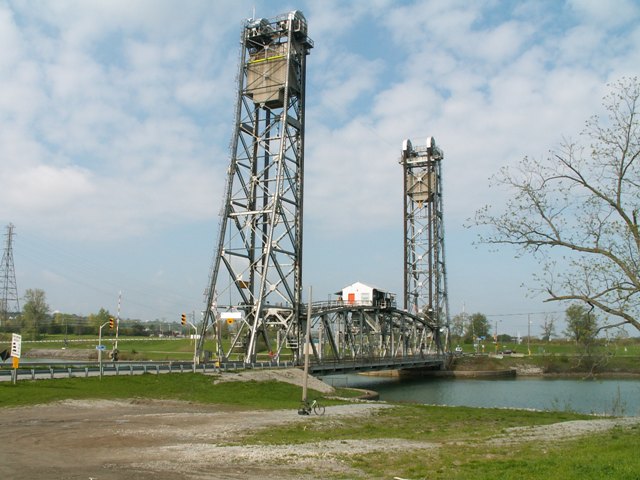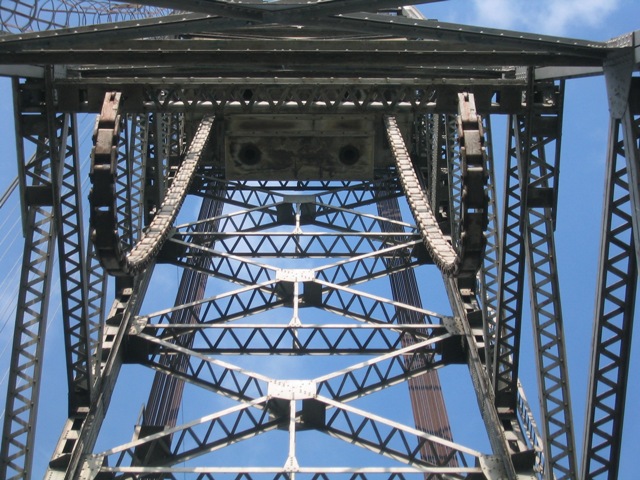We Recommend:
Bach Steel - Experts at historic truss bridge restoration.
BridgeHunter.com Phase 1 is released to the public! - Visit Now
Glendale Avenue Bridge
Welland Canal Bridge #5

Primary Photographer(s): Nathan Holth
Bridge Documented: May 15, 2005 and March 20, 2012
St. Catharines: Niagara Region, Ontario: Canada
Metal 9 Panel Rivet-Connected Parker Through Truss, Movable: Vertical Lift (Span Drive)
By Builder/Contractor: Unknown and Engineer/Design: Ash, Howard, Needles, and Tammen of New York, New York
Not Available or Not Applicable
Not Available
Not Available
Not Available
1 Main Span(s)
Not Applicable

View Information About HSR Ratings
Bridge Documentation
View Historical Articles About The Welland Canal and Its Bridges
There are a number of vertical lift bridges on the Welland Canal. While all are beautiful heritage bridges, and each has something that sets them apart from the rest, they were all built to a standard plan and have a similar design style and appearance.
The Glendale Avenue Bridge is an example of a standard truss vertical lift bridge over the Welland Canal. The actual bridge span is a Parker through truss. It has nine panels. Connections are riveted, and numerous built-up beams are present including v-lacing on the verticals and lattice is on the bottom of the top chord.
The towers of the bridge have the appearance and construction of a truss bridge themselves. Many members on the towers are built-up and v-laced, and a-frame bracing forms a portal for the towers. The east portal bracing for the towers has been replaced. It is likely that some tall truck creamed the originals, necessitating their replacement. It should be noted that the clearance is posted on the bridge, so such an accident should not have occurred if truck drivers paid any attention.
The bridge retains excellent historic integrity. There are no guardrails for cars (curbs only), which is how the bridge was built. There are ornate lattice guardrails with scrollwork designs on top for the cantilevered pedestrian sidewalks on both sides of the bridge. These guardrails can be found on many Welland Canal Bridges, including on some of the other bridge types found on the canal. Signs near the vertical lift bridge indicate that the bridge is now remotely controlled, using cameras. Apparently, thanks to computers, one person can operate any number of bridges from one location these days. Originally, a bridge tender would have been on-site to operate the bridge.
The towers of the bridge are quite tall, and huge concrete counterweights hang from them. Huge chains are attached to part of these counterweights. There is no one stationed right at the bridge anymore to operate it.
When HistoricBridges.org first wrote a narrative for this bridge in 2005, praise was offered not only for the good condition this bridge had been maintained in, but also for Ontario in general. At that time, it appeared that Ontario had a greater concern for preserving its heritage bridges than places like Pennsylvania and Missouri. However, since that time, Ontario has demolished a disturbing number of heritage bridges. In particular, the Niagara Region has since embarked on a heritage slaughter, going through the region and demolishing its heritage bridges one by one. The Welland Canal bridges are the only exception, since they continue to be in good condition. They may soon be the only heritage bridges left in Niagara Region.
![]()
Photo Galleries and Videos: Glendale Avenue Bridge
Structure Overview
Original / Full Size PhotosA collection of overview photos that show the bridge as a whole and general areas of the bridge. This gallery offers photos in the highest available resolution and file size in a touch-friendly popup viewer.
Alternatively, Browse Without Using Viewer
![]()
Structure Details
Original / Full Size PhotosA collection of detail photos that document the parts, construction, and condition of the bridge. This gallery offers photos in the highest available resolution and file size in a touch-friendly popup viewer.
Alternatively, Browse Without Using Viewer
![]()
Structure Overview
Mobile Optimized PhotosA collection of overview photos that show the bridge as a whole and general areas of the bridge. This gallery features data-friendly, fast-loading photos in a touch-friendly popup viewer.
Alternatively, Browse Without Using Viewer
![]()
Structure Details
Mobile Optimized PhotosA collection of detail photos that document the parts, construction, and condition of the bridge. This gallery features data-friendly, fast-loading photos in a touch-friendly popup viewer.
Alternatively, Browse Without Using Viewer
![]()
Maps and Links: Glendale Avenue Bridge
Coordinates (Latitude, Longitude):
Search For Additional Bridge Listings:
Additional Maps:
Google Streetview (If Available)
GeoHack (Additional Links and Coordinates)
Apple Maps (Via DuckDuckGo Search)
Apple Maps (Apple devices only)
Android: Open Location In Your Map or GPS App
Flickr Gallery (Find Nearby Photos)
Wikimedia Commons (Find Nearby Photos)
Directions Via Sygic For Android
Directions Via Sygic For iOS and Android Dolphin Browser


